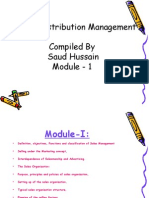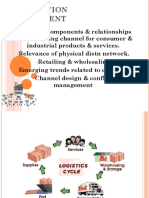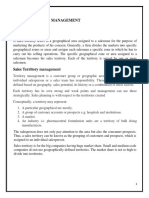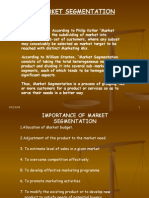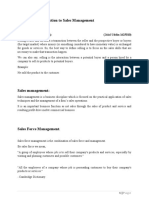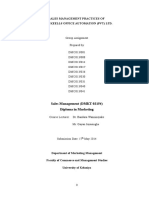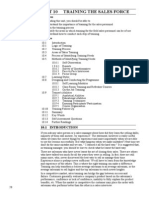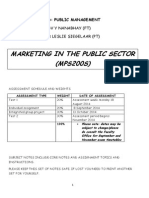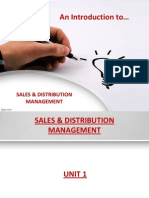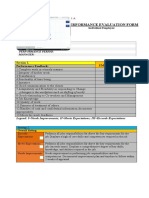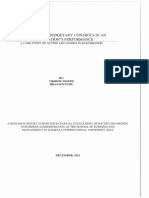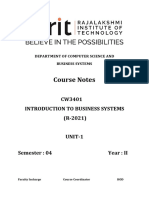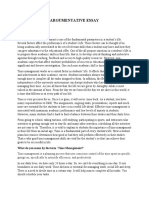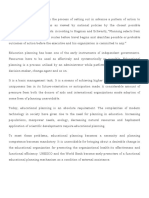Sales and Distribution (Mba MK 03) Unit 1
Sales and Distribution (Mba MK 03) Unit 1
Uploaded by
Christy WagnerCopyright:
Available Formats
Sales and Distribution (Mba MK 03) Unit 1
Sales and Distribution (Mba MK 03) Unit 1
Uploaded by
Christy WagnerOriginal Description:
Original Title
Copyright
Available Formats
Share this document
Did you find this document useful?
Is this content inappropriate?
Copyright:
Available Formats
Sales and Distribution (Mba MK 03) Unit 1
Sales and Distribution (Mba MK 03) Unit 1
Uploaded by
Christy WagnerCopyright:
Available Formats
SALES AND DISTRIBUTION (MBA MK 03) UNIT 1
LEC.1 INTRODUCTION TO SALES MANAGEMENT- SELLING AS A PART OF MARKETING Sales management originally reffered exclusively to the direction of the sales force personnel. Sales management meant management of all marketing activities , including advertising , sales promotion , marketing research , physical distribution, pricing and product merchandising. According to the committee of the American Marketing Association, the sales management meant , the planning, direction and control of personal selling , including recruiting, selecting, equipping, assigning, routing, supervising, paying and motivating as these tasks apply to the personal salesforce. Sales Management is a respectable function today, and its professional status is high as any other business function. Sales management provide critical inputs for the key marketing decisions like budgeting , quotas and territory management.
From the company viewpoint , there are three general objectives of sales management : Sales volume Contribution to profit Continuing growth
Top management delegates to marketing management, which then delegates to sales management , sufficient authority to achieve the three general objectives.
Purpose of sales force in any organization To facilitate the development Coordination and balance Interdepartmental conflicts
SALES MANAGEMENT PROCESS A motivated sales team always achieve profitable goal for their organization. In todays globalized world the success of the organization depend on the success of its employees. Whole management of sales can be improve by the process and different steps of sales management, which is as follows: A. Planning and Control: It reduces hesitancy and false steps-Henry fayol Planning is looking ahead on the basis of the present and the immediate past. And Control operates on everything things, people, actions. B. Reports: i)daily report ii)weekly report iii)tour programme C. Monthly Performance Review: Each sales rep to report personally to the branch office once in a month. D. Sales i) ii) iii) iv) Training: Presentation techniques Techniques to prompt and handle participation The methodology of role-playing, which can be valuable assistance in developing sales skills. The use of training films.
E. Presentational techniques: This section is designed to highlight key factors which can be used to make your presentation more effective. F. Ensuring that learning takes place:
ROLE OF SALES MANAGER A successful sales manager must posses administrative , conceptual , technical , and human relation skill which a salesman may not possess. Of course, selling experience is an asset because a sales meneger manages the sales force that performs the selling job. But both these are two different aspects. A successful salesman may not always make a successful sales manager. A sales manager jobs has two dimensions ----- planning & operating Planning function includes the following: 1. Design a sales programme. 2. Establish and manage a sales organisation. 3. Control the sales performance. 4. Set the sales goals, formulate the sales policies, and design the sales strategies. 5. Prepare a sales plan to implement the sales objective.
The operating functions include: 1. 2. 3. 4. Manage the sales force. Interact with other departments. Interact with the trade and customers. Interact with the marketing department and report to the marketing manager.
Characteristics of Sales managers 1. 2. 3. 4. A sales manager must visualize. A sales manager must do the right selection. He should do the proper time management. He should be an effective leader.
LEC. 3 CONCEPT OF PERSONAL SELLING Personal selling is a part of the total promotional activity of the firm, which along with product, price, and place management, goes a long way in meeting the overall marketing objectives of
the organization. The ultimate objective of the marketing function is to increase the sales of want-satisfying products and services, thus leading to a healthy bottom line. Of the several tools available to stimulate sales, one more important tool is personal selling. WHAT IS PERSONAL SELLING It is a method of communication----- a sales person communicates on an individual basis with a prospect. Personal selling is person to person communication. It is also possible to get immediate feedback in personal selling by observing the reaction of the prospect, and thus communication can be modified on the spot. Advertising may be receive by those who are not our target audience . Personal selling is focused directly on our target audience. Situations in personal selling:1. Establish product & ongoing relationship with the sales executive. 2. Established product & new relationship. 3. New product & ongoing relationship. 4. New product & new relationship.
SALES MANAGEMENT AND SALESMANSHIP Sales management , is the direction of the personal selling effort . Mostly, this is accomplished through salesmanship . A salespersons job has many activities , including salesmanship. A sales manager has to understand these. A sales person faces many problems, some of which are related to salesmanship. A salesmanager must understand these and provide the right solutions. Salesmanship is defined by Shapiro as the art of persuation which motivation the customers to buy products which provide them suitable benefits. Salesmanship is initiated by the seller and provides information to the prospective buyers about the products and their benefits so as to persuade and motivate them to opt for them.
LEC. 4 PROCESS OF PERSONAL SELLING
There are six stages in Selling process , which are as follows:
Prospecting & Qualifying
Pre- approach & Approach
Sales Presentation & Demo
Handling Objections
Closing
Follow Up & Maintenance
LEC. 5 QUALITIES OF A SUCCESSFUL SALESMAN There are different qualities of a successman salesman : 1. 2. 3. 4. 5. 6. 7. 8. Personality Mental qualities Sociability Vocational skills Communication ability Patience Determination Dependability
LEC. 6 GOALS IN SALES MANAGEMENT: GOAL SETTING PROCESS IN SALES MANAGEMENT There are three main goals in sales management. They are: (i) Adequate sales volume to be achieved
(ii) (iii)
Maximum contribution to profits Continuing growth To fulfill these goals and objectives the top management delegates power to marketing management which further pass it to sales management which finally set the future operations. GOAL SETTING PROCESS: The duty of a sales manager is to look after and managing the companys personal selling for achieving this goal he has to adopt sales management goal setting process which is as follows: 1. Analysis : (a)to analyse the sales records (b)reports of sales people (c) knowing market trends (d) other environmental factors 2. Planning : (a) formulating goals for the companys sales efforts (b)developing sales strategies and policies for achieving those goals 3. Organization : (a)formation of sales force (b)delegation of authority for achieving companys goal 4. Direction : (a)to supervise and implement the plans properly and in the direct direction (b)for this proper communication motivation and right leadership is required 5. Control : (a)to find out the difference between actual and targeted results (b)to find out the cause of deviation , if any (c) ultimately taking corrective action to solve them
LEC. 7 ANALYZING MARKET DEMAND AND SALES POTENTIAL According to Philip Kotler, Market demand for a product is the total volume that would be bought by a defined customer group in a defined geographical area in a defined time period in a defined marketing environment under a defined marketing program. MARKET DEMAND : In it the firm need to assess : (i) Current market demand (ii) future market demand
(a) Current market demand : it consist of two types of assessment which are: 1. Total market demand : this can be calculated by sales forecasting. 2. Area market demand : (i)It refers to the demand within a particular area which can be either a district, state or country. (ii)It has two methods (a) Market build up method: It identifies : (i)the quantity of potential buyers in each market and (ii)to estimate the quantity of their potential buying (b)Market factor index method : It identifies : (i)those market factors which have coordination with market potential and (ii)then these factors unite them with a weighted index
(b) Future market demand includes the following: (i)forecasting total demand and (ii)forecasting area demand which depends upon the forecasting total demand.
SALES POTENTIAL: According to Still and Cundiff, A sales potential is an estimate of the maximum possible sales opportunities present in a particular market segment open to a company selling a good or service during a stated future period. A sales potential represents sales opportunities available to a particular manufacturer while a market potential indicates sales opportunities available to an entire industry.
The sales potential is larger than the sales forecast as: (i) (ii) (iii) (iv) Some firms lack sufficient production capacity to achieve the full sales potential. Other firms lack distributive networks to reach every potential customer . Others do not consider their total sales potential due to lack of their financial resources Still others are more profit oriented rather sales oriented. Thus the estimate for sales potential shows how much a firm can sell if it had all necessary requirements and ready to use them.
Lec. 8 Techniques of Sales Forecasting The following methods and techniques are used for forecasting sales of a company: 1. Jury method/executive opinion method Most common and prevalent method. The base of this method is judgement hence also called executive opinion method. In this method all the participants give their judgement and opinions. The final forecast is determined by averaging these opinions. 2. The Delphi method It is also a kind of expert opinion which is used for broad based future estimates. It this method a sequence of questionnaires are put on a panel of experts in this field. All members provide their individual information to others in the panel. Then panel is asked to check the questions which are important to the forecast. Their answers and reactions are analysed and if there is any sharp differences in opinions, it is again discussed and final forecast is formulated. 3. Sales force composite method The sales forecasting is done by sales force and is also a judgement based method. In it each salesman predict the forecast for his territory. All such forecasts are then consolidated at regional level and the sum of all these forecasts develops into the firms forecast . It is thus called a grass root method as the judgement of the are nearest to the market place forms the basis of the forecast.
4. User Expectation method/survey of consumers opinion method The sales forecasting is done after surveying the buyers intentions. A list is demand forecast is consolidated. Thus, the survey of buyer will provide(i) The total likely consumption of the product. (ii) The consumers buying plan. (iii) The market share for the enterprise.
5. Market share method The company first chalk out the industry forecast and then applies the market share factor of the company forecast. The market share factor is prepared from companys past trends, present position, plans for future and brand preference etc. It requires great expertise to correctly assess through marketing intelligence, its competitors plans, policies and activities. 6. Analytical and statistical methods/Trend analysis Under this method of sales forecasting , the past data of sales of the enterprise are analysed and the trend is established. Forecasting for the future are made on the basis of this trend. 7. Market survey method This method is most suitable for the sales forecasting of the new product. Under this method , some certain segments are selected and the product is introduced in these segments only. The result of sales in these segments are collected and analysed and on the basis of these results, the sales forecasts are made for the whole market.
Sales Budget:
Sales budget is an important part of sales forecasting. A sales budget is a forecasting of a new product or of an enterprise for a certain period of time. Sales budget is prepared after preparing sales forecast. Sales budget is considered to be a most impotent budget of an enterprise budget because all other budgets, such as production budget, Raw Materials budget, labour budget, plant budget, overheads budget etc. A sales budget is prepared by sales manager or marketing manager with the help of marketing research manager, regional sales manager, branch manager and salesman.
Factors to be considered while preparing a sales budget: There are many factors which must be considered while preparing a sales budget. It can be divided into following two parts1. Internal factors: Important internal factors which affecting the sales budget are as under(i) (ii) (iii) (iv) (v) (vi) (vii) (viii) (ix) (x) (xi) (xii) (xiii) (xiv) (xv) Volume of sales of the enterprise Trend of the sales of the enterprise Long term trend of the sales of the enterprise Profitability of different products of the enterprise Production capacity of the enterprise Expansion programme of the plant of the enterprise Plan of new products Product diversification Plan or product development Seasonal fluctuations Selling and distribution channels Possibilities of marketing research Price policy Advertisement and sales promotion policy Ability and efficiency of salesman,etc.
2. External Factors: External Factors affecting the preparation of a sales budget, These are as under: (i) (ii) (iii) (iv) (v) (vi) (vii) (viii) (ix) (x) (xi) General economic condition of the country General atmosphere of the industrial development of the country Condition of a particular industry Changes in population National production and per capita national income Distribution of wealth in country Situation of competition in the market Changes in the needs , habits and tastes of consumers Industrial and taxation policy of the government Purchasing power of general public Trade conditions in the country etc.
LEC. 9 Formulating selling strategies Objectives are achieved through strategies. Policies provide the guidelines. Selling strategies have two types of dimensionswhat type of salesforce is needed and how many of sales people are needed. The different strategies of sales are as follows: Types of sales persons: It is a key question in selling strategy. The consideration are the expectations of the organization from the salesforce and the measurement of performance. Each organization has its individual requirements. Each organization has its own strengths and weaknesses in terms of product it sells. Product market analysis: Selling task varies from customer to customer, and market to market. To take an extreme example, a salesman may sell a single product to several different types of customers. Another extreme is to sell a diversity of products to a single types of customer . sales persons can be product specialists or market specialists or product market specialists. Role in securing orders: A sales persons role in securing orders also affect the type of sales persons required. In different selling environments, the order securing process operates differently, e.g., some have to solicit orders aggressively such as computer salesman whereas some just accept orders which come their way such as a salesman of government textbooks prescribed for primary and secondary schools. Basic selling styles: The four basic selling styles: trade selling , technical selling, missionary selling and new-business selling. Trade selling tries to establish long-term relationship with the customers. This is a routine job. In wholesale trade, this style is used extensively. Technical selling aims at improving sales volume of established products by offering sound technical advice and other assistance.
Missionary selling assists the customers in their selling efforts. The idea is to increase the sales volume. If orders flow in, they are just incidental. A medical representative is a typical missionary. New-business selling tries to identify new customers and secure orders from them. He converts the prospects into customers. Selling for him is a creative job. He should have good selling skills. Size of the sales force The second dimensions of selling strategy is the size of the salesforce. An organization first decides what type of sales people it requires and then how many of them are necessary so as to meet the sales and profit objectives. Too few sales people mean loss of opportunities and too many of them, unnecessary expenditure. The exact number of sales people a company must have is difficult to pin point. Customer, Tailored Selling Strategies Strategy of selling ultimately is tested against interactions of the salespeople with the customers; which lead to the realization of the selling objectives. The type of sales persons required and their number are the first two key decisions taken by a company. Later the focus is on developing an individual selling style, which is mutually beneficial. All said and done, a salesman achieves success by his interactions with the customers. His behaviour may vary from customer to customer. The extent of this variation is a matter of selling skills. This calls for pre-planning and the actual performance during the call.
LEC. 10 Designing sales territories and sales Quota Sales territory A geographical grouping of customers and prospects is called a sales territory . operationally it is a group of customers assigned to a sales person. In it customers are important rather than the areas in which a salesman work. Designing sales territories It means dividing the market into similar customers making homogeneous market area. Market data is more useful when collected and applied at the territory level. To
implement planning and control the market area should be broken up into a number of well designated sales territories.
Definition According to Still & Cundiff, A sales territory is a grouping of customers and prospects assigned to an individual sales person. Criteria for Territory design Sales territory design should be(i) (ii) (iii) For easy administration and right approach Feasible having equal work load and equal potential. Divided into marketing regions and district etc, to cover total marketing area.
SALES QUOTAS Quotas are quantitative objectives which are assigned to individual sales personnel or a sales unit (a district or region or territory) for a particular period of time by the sales department. These appraise the selling effectiveness of the company. sales quota is a goal in terms quantity given to a sales representative, or a group of sales representatives over a period of time. Sales quota may be assigned to a region , territory, branch office. It may be assigned to a distributor too. Sales quotas are the tools of planning and control. Sales quotas are based on sales forecasts and sales potentials of different markets. The more accurate the data used in formulating the sales quotas, the more effectives quotas become. Sales efforts is controlled by using quotas. It helps in appraisal. It helps in controlling expenses. Quotas provide a quantitative performance standards. Quotas are used as performance criteria in sales contests. Sales forecast is the first step in setting up quotas. It leads to the sales budget. In the budget, there is a provision for setting quotas as performance standards.
UNIT 2 Lec. 11 Sales force Management The success of any sales organization depends upon the ability, skill and willingness of the sales force in achieving the desired sales objectives. The willingness to do the work will enhance his performance level. The willingness depends upon the motivation he gets. Thus, motivation provides willingness which is quite different from his ability or capacity in doing his job. Therefore, there are two factors in determining the performance of the salesforce which are his1. Ability and skill 2. Motivation Ability and skill can be developed through education and training Willingness and interest to perfect well can be achieved through proper motivation. Thus, motivation can enhance greater selling efficiency in the form of higher sales volumes. A motive is an emotion within an individual which incites and encourage him to perform well. Motivation can be aroused by some external stimuli or incentive.
Lec. 12 Organizing the sales force: The following Common approaches are used in organizing the sales force: 1. 2. 3. 4. 5. Customer based organisation : The cretria for thease approch Product based organization Territory based organization National account based organization Inside/outside sales based organization
Lec. 13 Sales force structure: (i) (ii) (iii) (iv) It requires when the company sells different variety of products to different types of customers over a large geographical area. It combines many types of sales force structures. Sales people are trained for territorial or product or market structure knowledge. Then, these sales people have to report to one or more line and staff managers.
The sales force is very important in marketing mix. Hence, companies need to carefully consider when and how to use sales representatives. For this, companies are substituting inside mail and phone based selling units to reduce field sales expenses and they are trying to increase the productivity of the remaining sales force through better selection, training, motivation and compensation. Sales personnel serve as the companys personal link to the customer.
Lec. 14 Size of sales force: (i) (ii) (iii) (iv) It is the most important asset and major component of companys promotion mix. It decides the companys fate as revenues are provided through sales. Its effectiveness determines overall marketing objectives of the firm. Sales force is required for various kinds of services.
Sales force size: (i) (ii) (iii) (iv) (v) A company after formulating its sales force strategy and structure start considering its sales force size. It is usually fixed at the optimum level. It includes expected level of sales together with the number of sales persons required for such sales. Increasing the number of their sales representatives will increase both sales and costs. Thus, the sales force size can be established on the number of customers they want to tackle.
Note: It is called work load approach by Philip Kotler which is as follows : (i) (ii) (iii) (iv) (v) (vi) (vii) (viii) The buyers are categorized according to their yearly sales volume. Then, the call frequencies per year is established for each category. The number of accounts for each category is multiplied by the call frequencies to find out the complete work load in sales call per year. Through it, the number of calls a sales person can utilize per year is find out. By dividing the total year calls needed with the average year calls done by the sales person can determine the number of sales persons required by the company. The size of sales force depends upon its structure and productivity and some other factors. The size is also changeable according to the companys market conditions. The company determines the sales force size upon its affordability and its requirements for the job.
Lec. 15 Recruitment of the sales force: The main responsibility of any companys sales executives is to recruit and select the executive should implement personal selling strategy in considering both the kind and quantity of sales personnel. Individual are recruited by their varying abilities, skills, education, training, experience. The scope of recruitment depends upon (i) (ii) (iii) (iv) Number of recruits required. Size of sales company. Rate of turn over and Forecasted sales volume and distribution channels.
Importance of recruitment: (i) (ii) (iii) It is essential to carry out the selling activities of the company to recruit the right type of sales person having all the desired qualities. For this, a sound recruitment policy is required for the success of any organization. The management should choose the right man for the right job or else they will become burden on them.
(iv) (v) (vi)
A stable and efficient work force can only achieve organizational goals and objectives in a systematic planned manner. Only a right type of sales force once recruited can increase sales and profit to an organization. Thus, recruitment of salesman in an endless job for any company.
Need for continuous recruitment: 1. Vacancy created 2. Expansion programmes
Sources of recruitment : 1. Internal sources 2. External sources (i) Advertisement (ii) Employment agencies (iii) Existing employees (iv) Older people (v) Salesman of non-competing companies (vi) Salesman of competing companies (vii) Direct application (viii) Wholesellers and retailer
Lec. 16 Selection of sales force After determining the type and number of sales persons the sales department requires, the applications for the job have been received, the company is prepared to deal with the final stage of the selection system i.e., selection process. It involves to select the individuals out of the so many applicants which best fit the needs of the company. The main purpose of selection is to find out the right person for the right job in an enterprise. Selection of sales personnel can be done in two ways-
(i) (ii)
Either through simple system by applying an informal personal interview Or through complex system by using diverse mechanism to gather information about applicants for sales jobs. A complex selection system is a set of successive screening such as Applications Preliminary interview Qualifications References Testing Physical conditions Employment offer
Lec. 17 Leading and motivating the sales force Motivation is behaviour towards reaching the desired goal. The need within individual leads a person to act so as to achieve it. Thus, motivation for sales personnel is amount of effort required for his sales job i.e., (i) (ii) (iii) Calling on potential customers Planning sales deals and Preparing reports etc.
Need for motivation There is a need for motivation for sales personnel in order1. To improve efficiency
2. 3. 4. 5.
To remove tension Keep them satisfied Provide human treatment Motivation tools
Motivation and leadership (i) (ii) (iii) (iv) Effective sales executives act as leaders of sales personnel and get voluntary cooperation from them to reach the sales departments goal. They very well know the motives, desires and ambitions of the sales persons and use this knowledge to guide them in their activities. The leadership requires to keep good relationship with the sales personnel which requires skills, experience, maturity and common sense. They should treat them fairly in assigning jobs, promotions and remunerations etc.
Lec. 18 Training and compensating the sales force The increasing demand of demand of present world of marketing requires competent and well trained salesman as a companys success and progress depend greatly on the efficiency of its sales force. now-a-days only proper trained sales person can improve the maximum potentiality of any organization hence, well trained sales force can be a valuable asset for it to face the modern marketing.
You might also like
- Rework On Google StoryDocument8 pagesRework On Google StoryChhavi Khurana100% (1)
- CASE 1 GROUND ZERO - Set 3 (Group Numma)Document24 pagesCASE 1 GROUND ZERO - Set 3 (Group Numma)Furqan AnwarNo ratings yet
- Sales Management Notes FinalDocument88 pagesSales Management Notes Finalsatya_bunty92% (12)
- Capstone - Sales ManagementDocument105 pagesCapstone - Sales ManagementMàrius Petit Vidal50% (2)
- Sales Force ManagementDocument7 pagesSales Force ManagementFisher100% (1)
- How To Answer The Most Frequently Asked Top MBA Interview QuestionsDocument8 pagesHow To Answer The Most Frequently Asked Top MBA Interview QuestionsAnonymous eILCSdHqJNo ratings yet
- CoachingDocument43 pagesCoachingAnonymous 5Vk9vlQd8No ratings yet
- Organizational LeadershipDocument25 pagesOrganizational Leadershipwarda wisaalNo ratings yet
- Professional Salesmanship OBTLPDocument11 pagesProfessional Salesmanship OBTLPIvan JamitoNo ratings yet
- Sales ManagementDocument88 pagesSales Managementvicky241989No ratings yet
- Introduction To Sales ManagementDocument31 pagesIntroduction To Sales Managementvinaycool12344150No ratings yet
- Global Sales StoryDocument4 pagesGlobal Sales StoryLinnet FurtadoNo ratings yet
- Sales Management ConceptsDocument34 pagesSales Management ConceptsKumar KeshavNo ratings yet
- Distribution ManagementDocument104 pagesDistribution ManagementmansiNo ratings yet
- Sales Territory ManagementDocument22 pagesSales Territory Managementhema sri medi100% (2)
- Sales Territory DesignDocument16 pagesSales Territory Designshweta_46664100% (11)
- Sales ManagementDocument17 pagesSales ManagementMadanBashyal01No ratings yet
- Sales and DistributionManagementDocument90 pagesSales and DistributionManagementGuruKPO100% (7)
- Market SegmentationDocument9 pagesMarket SegmentationHARSHAD85% (13)
- 2.strategy & Strategic ManagementDocument28 pages2.strategy & Strategic ManagementDevraj SinghNo ratings yet
- Marketing Management Department Unilab Sales Management Procedure (Sales Management Procedure)Document36 pagesMarketing Management Department Unilab Sales Management Procedure (Sales Management Procedure)Jan AcostaNo ratings yet
- Sales ManagementDocument77 pagesSales Managementdhavalbheda141100% (6)
- Operations ManagementDocument24 pagesOperations ManagementSusmita BasuNo ratings yet
- 4.91 Master of Management Systme MMS Sem I and IIDocument51 pages4.91 Master of Management Systme MMS Sem I and IIAnagha PranjapeNo ratings yet
- Sales TrainingDocument26 pagesSales Trainingsrra100% (1)
- Market Segmentation, Targeting and PositioningDocument25 pagesMarket Segmentation, Targeting and Positioningsimply_coool67% (3)
- CONSUMER BEHAVIOUR UpdatedDocument66 pagesCONSUMER BEHAVIOUR UpdatedUmer AzizNo ratings yet
- Burke-Litwin Change Model: Approaches To Managing Organizational ChangeDocument11 pagesBurke-Litwin Change Model: Approaches To Managing Organizational Changeankitgautam89No ratings yet
- Market SegmentationDocument4 pagesMarket SegmentationMuzaffar IqbalNo ratings yet
- Selection and Training of Sales ForceDocument23 pagesSelection and Training of Sales ForceSelena Torres67% (3)
- Sales & Retail ManagementDocument158 pagesSales & Retail ManagementShariful Islam100% (1)
- Logistics and Its Problems in IndiaDocument20 pagesLogistics and Its Problems in IndiaAshish NirmalNo ratings yet
- Sales Management PracticesDocument38 pagesSales Management PracticesZaeem Barry100% (1)
- Introduction To Marketing ManagementDocument13 pagesIntroduction To Marketing ManagementOnajNo ratings yet
- Mit90s FrameworkDocument54 pagesMit90s Frameworkapi-26054027No ratings yet
- Planning Sales Dialogues and PresentationsDocument41 pagesPlanning Sales Dialogues and PresentationsJC Garcia100% (1)
- SDM Module 5 & 6Document40 pagesSDM Module 5 & 6Nivedita AtreNo ratings yet
- What Is Sales ManagementDocument44 pagesWhat Is Sales ManagementProfessor Sameer Kulkarni99% (188)
- Contemporary Issues in ManagementDocument21 pagesContemporary Issues in ManagementKNOWLEDGE CREATORS75% (4)
- 10 Steps To An Effective Marketing PlanDocument5 pages10 Steps To An Effective Marketing Plansai143me100% (4)
- Marketing and SalesDocument5 pagesMarketing and SalesAnkur MathurNo ratings yet
- Execution: The Discipline ofDocument68 pagesExecution: The Discipline ofYasser ElFar100% (1)
- Entrepreneurship SyllabusDocument5 pagesEntrepreneurship SyllabusPrafful AgarwalNo ratings yet
- Value Chain AnalysisDocument19 pagesValue Chain AnalysisPradeep Biradar100% (1)
- 3 Creating Customer Value & Customer RelationshipsDocument35 pages3 Creating Customer Value & Customer RelationshipsFaryal MasoodNo ratings yet
- Sales TrainingDocument25 pagesSales TrainingAmaresh100% (1)
- Sales Management Module 4 StudentsDocument7 pagesSales Management Module 4 StudentsJan AcostaNo ratings yet
- Strategy ManagementDocument106 pagesStrategy ManagementGirish Harsha100% (9)
- Service MarketingDocument55 pagesService MarketingRannSamonteNo ratings yet
- Sales TerritoriesDocument17 pagesSales Territoriesravishekramdev100% (2)
- Marketing AssignmentDocument13 pagesMarketing AssignmentNoman Ul Haq SiddiquiNo ratings yet
- CRM Implementation ProcessDocument1 pageCRM Implementation ProcessPuneet Kumar100% (1)
- Strategic Intent and Strategy FormulationDocument31 pagesStrategic Intent and Strategy FormulationPratik WANKHEDENo ratings yet
- Unit-10 Training The Sales Force PDFDocument12 pagesUnit-10 Training The Sales Force PDFbhar4tpNo ratings yet
- Chapter 4 Sales Force ManagementDocument46 pagesChapter 4 Sales Force Managementapi-3719928100% (6)
- Channel StrategyDocument32 pagesChannel StrategySarika WaliaNo ratings yet
- Marketing in The Public Sector - Course Notes-2014Document69 pagesMarketing in The Public Sector - Course Notes-2014jnax101No ratings yet
- Sales and Distribution (Mba MK 03) Unit 1Document20 pagesSales and Distribution (Mba MK 03) Unit 1bvsmurthyjnncembaNo ratings yet
- Sales and Distribution (Mba MK 03) Unit 1Document23 pagesSales and Distribution (Mba MK 03) Unit 1Preeti ChauhanNo ratings yet
- Sales ManagementDocument9 pagesSales ManagementrajeeevaNo ratings yet
- Sales & DDocument64 pagesSales & Dgeethu pgNo ratings yet
- SDM NotesDocument32 pagesSDM NotesAkshata KaleNo ratings yet
- An Introduction To : Sales & Distribution ManagementDocument101 pagesAn Introduction To : Sales & Distribution ManagementMukti Prakash BeheraNo ratings yet
- Sales Management NotesDocument21 pagesSales Management NotesSaurabh RaiNo ratings yet
- Relarionship MarketingDocument8 pagesRelarionship MarketingShanthi VenkateshNo ratings yet
- Performance Evaluation FormDocument3 pagesPerformance Evaluation FormMarjonNo ratings yet
- 9 Things A Leader Must Do Cloud en 40967Document6 pages9 Things A Leader Must Do Cloud en 40967Febi Esteria GirsangNo ratings yet
- Attachment CDocument6 pagesAttachment Capi-540416622No ratings yet
- Lab ManDocument212 pagesLab ManVert MochiNo ratings yet
- Typical Job Interview Questions With Sample AnswersDocument22 pagesTypical Job Interview Questions With Sample AnswersΠαναγιώτης Νικ. ΜπούκαςNo ratings yet
- The Effects of Budgetary Controls in An Organization'S PerformanceDocument56 pagesThe Effects of Budgetary Controls in An Organization'S PerformanceYalew WondmnewNo ratings yet
- Program Plan - Art CampDocument11 pagesProgram Plan - Art Campapi-287578804No ratings yet
- Lesson 8 Sikolohiyang FilipinoDocument45 pagesLesson 8 Sikolohiyang FilipinoNini JimbuuNo ratings yet
- Types of Educational Planning Reasons Fo PDFDocument25 pagesTypes of Educational Planning Reasons Fo PDFJannet Francia Ong SorretaNo ratings yet
- Character Arcs in Romantic Comedies HandoutDocument8 pagesCharacter Arcs in Romantic Comedies HandoutAinge IshikawaNo ratings yet
- Essentials of ManagementDocument5 pagesEssentials of ManagementjishnuNo ratings yet
- CW3401-IBS - Unit 1 NotesDocument13 pagesCW3401-IBS - Unit 1 NotesSrinithiNo ratings yet
- Lesson Plan 4 Flag Day - Semester 6 1Document3 pagesLesson Plan 4 Flag Day - Semester 6 1api-307404330No ratings yet
- The Balanced ScorecardDocument17 pagesThe Balanced Scorecardagustine96gmailcomNo ratings yet
- "The Consulting Process" The Eight-Phase Consulting Model, The Human Performance Technology Model, and The Human Performance Improvement ModelDocument7 pages"The Consulting Process" The Eight-Phase Consulting Model, The Human Performance Technology Model, and The Human Performance Improvement ModelKavitha RagupathyNo ratings yet
- Argumentative EssayDocument4 pagesArgumentative EssayArmeen Amin0% (1)
- Functions of Public Administration 2 1 1 1 2 1 1 1Document36 pagesFunctions of Public Administration 2 1 1 1 2 1 1 1nayabNo ratings yet
- 1 PDFDocument44 pages1 PDFDr.V.Bastin JeromeNo ratings yet
- Educational Planning CHARACTERISTICSDocument3 pagesEducational Planning CHARACTERISTICSAliejah Casan75% (8)
- Diass (Module 6)Document41 pagesDiass (Module 6)Jocelyn Baculi AutenticoNo ratings yet
- Q1 Food Processing NC II (Fish) 10 - Module 1 (W1-2)Document14 pagesQ1 Food Processing NC II (Fish) 10 - Module 1 (W1-2)Wynne ElevadoNo ratings yet
- Strategy Implementation Strategy Implementation and Its ProcessDocument4 pagesStrategy Implementation Strategy Implementation and Its ProcessReymond AdayaNo ratings yet
- Guía Pedagógica. Educación Física 11°Document11 pagesGuía Pedagógica. Educación Física 11°Kevin Felipe Carrillo EspinosaNo ratings yet
- HR Divisional Business Drivers and KPI Development WorkshopDocument47 pagesHR Divisional Business Drivers and KPI Development Workshopcheqjieja100% (1)












